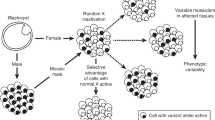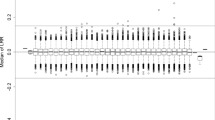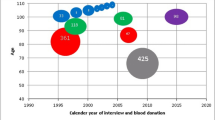Abstract
THE inactive-X hypothesis states that only one of the two X chromosomes in each somatic cell of adult mammalian females is genetically active. The initial event in early embryogenesis which determines whether the paternal or the maternal X chromosome will remain active in any given cell is presumably random; once made, the choice is fixed for that cell and for all its descendants1–4. Although this type of inactivation has been demonstrated in man for a number of X-linked loci5, it is not known whether the entire X chromosome is inactivated.
This is a preview of subscription content, access via your institution
Access options
Subscribe to this journal
Receive 51 print issues and online access
$199.00 per year
only $3.90 per issue
Buy this article
- Purchase on Springer Link
- Instant access to full article PDF
Prices may be subject to local taxes which are calculated during checkout
Similar content being viewed by others
References
Lyon, M. F., Nature, 190, 372 (1961).
Russell, L. B., Science, 133, 1798 (1961).
Beutler, E., Yeh, M., and Fairbanks, V. F., Proc. US Nat. Acad. Sci., 48, 9 (1962).
Davidson, R. G., Nitowsky, H. M., and Childs, B., Proc. US Nat. Acad. Sci., 50, 481 (1963).
Lyon, M. F., Annual Review of Genetics (edit. by Roman, H. L.), 31 (Annual Reviews, Inc., Palo Alto, California, 1968).
Gorman, J. G., Di Re, J., Treacy, A. M., and Cahan, A., J. Lab. Clin. Med., 61, 642 (1963).
Race, R. R., and Sanger, R., Blood Groups in Man, 522 (F. A. Davis Co., Philadelphia, Pennsylvania, 1968).
Lee, G. R., MacDiarmid, W. D., Cartwright, G. E., and Wintrobe, M. M., Blood, 32, 59 (1968).
Nowell, P. C., and Hungerford, D. A., Science, 132, 1497 (1960).
Sandberg, A. A., Ishihara, T., Crosswhite, L. H., and Hauschka, T. S., Blood, 20, 393 (1962).
Tough, I. M., Jacobs, P. A., Court Brown, W. M., Baikie, A. G., and Williamson, E. R. D., Lancet, i, 844 (1963).
Whang, J., Frei, III, E., Tjio, J. H., Carbone, P. P., and Brecher, G., Blood, 22, 664 (1963).
Trujillo, J. M., and Ohno, S. presented at Ninth Cong. Internat. Soc. Hemat. (Mexico City 1962).
Beutler, E., Yeh, M., and Fairbanks, V. F., Proc. US Nat. Acad. Sci., 48, 9 (1962).
Davidson, R. G., Nitowsky, H. M., and Childs, B., Proc. US Nat. Acad. Sci., 50, 481 (1963).
DeMars, R., and Nance, W. E., Retention of Functional Differentiation in Cultured Cells, 35 (Wistar Institute Press, Philadelphia, Pennsylvania, 1964).
Fialkow, P. J., Gartler, S. M., and Yoshida, A., Proc. US Nat. Acad. Sci., 58, 1468 (1967).
Fialkow, P. J., Lisker, R., Detter, J., Giblett, E. R., and Zavala, C., Science, 163, 194 (1969).
Whang-Peng, J., Canellos, G. P., Carbone, P. P., and Tjio, J. H., Blood, 32, 755 (1968).
Author information
Authors and Affiliations
Rights and permissions
About this article
Cite this article
FIALKOW, P., LISKER, R., GIBLETT, E. et al. Xg Locus : Failure to detect Inactivation in Females with Chronic Myelocytic Leukaemia. Nature 226, 367–368 (1970). https://doi.org/10.1038/226367a0
Received:
Issue Date:
DOI: https://doi.org/10.1038/226367a0
This article is cited by
-
STmut: a framework for visualizing somatic alterations in spatial transcriptomics data of cancer
Genome Biology (2023)
-
PBDX is the XG blood group gene
Nature Genetics (1994)
-
A comparative study on steroid sulfatase and arylsulfatase C in fibroblast clones from 45,X/47,XXX and 69,XXY
Human Genetics (1984)
-
Linkage of genes for chronic granulomatous disease and Xg
Human Genetics (1980)
-
Developmental, tissue-specific, and sex differences in activity among three enzymes from human erythrocytes and cultured fibroblasts
Biochemical Genetics (1973)
Comments
By submitting a comment you agree to abide by our Terms and Community Guidelines. If you find something abusive or that does not comply with our terms or guidelines please flag it as inappropriate.



